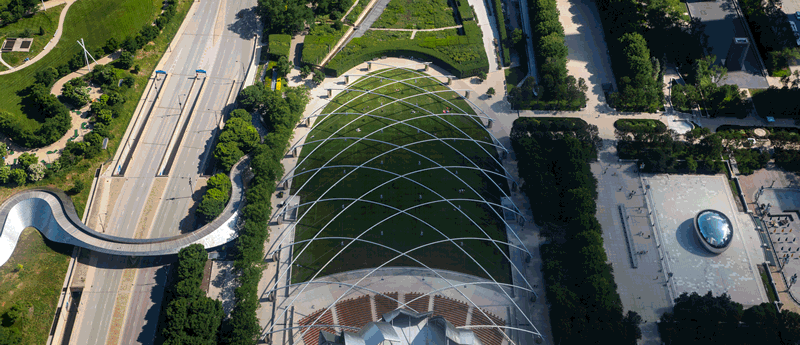
A view of the Pritzker Pavilion and serpentine BP Pedestrian Bridge that connects Millennium Park with Maggie Daley Park (formerly, Daley Bicentennial Plaza), both parts of the larger Grant Park. The bridge is referred to as snakelike in character due to its curving form.
Source: Credit to the City of Chicago
| Project Name | Millennium Park | |
|---|---|---|
| Location | Chicago, Illinois | |
| Project Sponsor / Borrower | City of Chicago, Millennium Park, Inc. | |
| Program Areas |
|
|
| Value Capture Techniques | Joint Development, Private Contribution including Naming Rights, and Tax Increment Financing (TIF) Fund | |
| Mode | Park & Parking | |
| Description |
Millennium Park is considered one of the largest green roofs in the world, having been constructed on top of a railroad yard and large parking garages. Millennium Park is located in the Chicago Loop area, adjacent to the eastern edge of the Central Business District and is made up of the northern section of the City's historic Grant Park. Millennium Park is three blocks south of the Chicago River and roughly two blocks west of Lake Michigan. It is owned and operated by the City of Chicago and programmed by the Department of Cultural Affairs and Special Events. Millennium Park is free and open to the public. Project development for Millennium Park dates back to the 1805 decommissioning of Fort Dearborn, coupled with the 1809 dedication of 20 acres of the Fort as a park. When portions of Chicago's 24.5-acre Grant Park were given to the Illinois Central Railroad Company in 1852 in exchange for the construction of another project, the area became an eyesore that divided Chicago's Loop district from the waterfront. In 1996, the City filed a lawsuit to regain control of the land. The initial plan was to convert the site into the new home for the Grant Park Music Festival and include a parking garage with a landscaped green roof that would be energy self-sufficient. To attract private donations, Millennium Park Inc. was formed and plans were expanded to include additional amenities. The new scope delayed project completion and increased project costs. The City invested in Tax Increment Financing (TIF) funds and a termination fee to financially support the project. Millennium Park was completed in 2004 and includes an ice rink, heated bicycle parking, showers, lockers, and food for daily commuters. One of the park's most iconic features is "Cloud Gate," a modern sculpture that allows visitors to view Chicago's cityscape. In addition to musical festivals, the Park also offers space for rotating art exhibitions and group theater performances. The park's pavilions generate enough solar power to offset the park's electrical utility costs. The entire structure is located atop a 4,000-car capacity parking garage. The Park is near major roadways and is easily accessible by public transportation including buses, elevated trains, and subway trains operated by the Chicago Transit Authority. Parking garages located beneath the Park are accessible via North and South Michigan Avenue and at upper and lower Columbus Drive. |
|
| Cost | $490 million |
|
| Funding Sources |
|
|
| Project Delivery / Contract Method | Public-Private Partnerships | |
| Private Partner |
|
|
| Project Advisors / Consultants | John H. Bryan | |
| Lenders | N/A | |
| Duration / Status | 1997-2004 |
|
| Financial Status/Financial Performance |
Of the $490 million it cost to fund this project, $270 million of the funds came from the City and $220 million from private donors. There were $175 million in construction bonds, $95 million in TIF bonds provided by the Central Loop TIF, $160 million ($1 million minimum donations from 105 individuals, foundations, and corporations), and $60 million was separate campaign for the Harris Theater for Music and Dance. |
|
| Innovations |
|
|
| Related Links / Articles |
|
|
| Contact |
Lara Ziemba; lziemba@mbres.com. 312-605-8585 https://millenniumparkfoundation.org/contact/ dcase@cityofchicago.org |
|